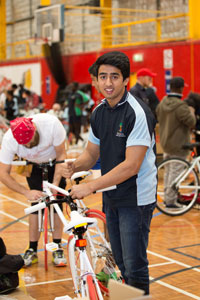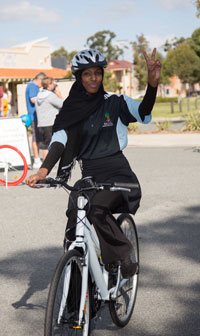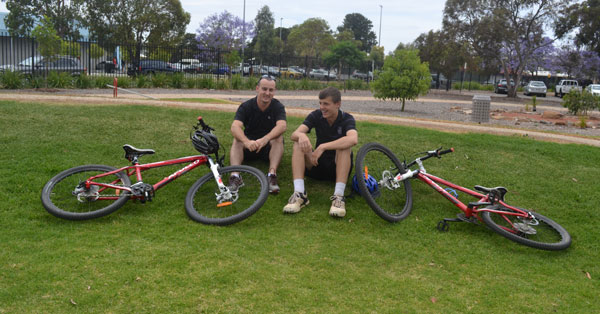Our adolescents need help to get active, for the sake of a healthy future. Simon Vincett and Phoebe Rountree investigate how adults and active transport can deliver.
Adelaide teen Matthew Pomery was, until recently, like many others his age. The 16-year-old caught the train to his school in the northern suburbs, Elizabeth–Fremont High, and to his job.
But transport became a lot more rewarding when the Happiness Cycle visited his area.
The program aims to get teens aged 13–16 physically active by giving them a bike, helping them build it and then measuring the activity they do afterwards.
Instead of catching the train, Matthew now rides his bike to school—a round trip of more than 30km.
And he’s already noticed a change in his life from riding a bike.
“My endurance has improved when it comes to sport, work and in life. I feel like I have energy each day,” Matthew says.
Even though it’s a 32km round trip from home, Matthew says he isn’t daunted. Though in the beginning it was tough, Matthew found it is actually not too difficult to ride that far.
“It is definitely achievable with a bit of practice and a bit of exercise,” he explains. “For the first few rides it seemed too long and too hard but now I’m doing it like it’s nothing.”

The 16km one-way trip takes Matthew between 30 minutes and an hour, depending on the weather. This means his total commute easily takes care of the minimum amount of physical activity recommended for his age, which is 60 minutes. Matthew knows that his new-found activity is good for him and speaks of the benefits with the insight of experience.
“It makes me happier to know I’m doing something active and healthy for my body,” he says. “It definitely is important to be active because it affects the way you look on life.”
Matthew is the exception rather than the rule. Sadly, most Australian adolescents are not physically active enough to be healthy, and the number is steadily growing.
A 2013 study, Young adult perceptions of Australia’s physical activity recommendations for adults, found “the percentage of young Australians aged 15–19 years who are inactive increased between 1989–90 and 2007–08 from 43% to 53% for males and 63% to 71% for females”. It also found that “globally, physical inactivity is the fourth leading risk factor for mortality.”
It’s no better for adults.
The Physical Activity in Australia survey (2011) found the most common level of exercise reported was none. People who were ‘sedentary’ made up 40%. The report showed 62% of Australian adults don’t meet the recommended physical activity guidelines meaning two-thirds of Australian adults don’t exercise for at least 30 minutes a day, (the minimum required to maintain health).
Setting healthy habits young is the key to lowering these statistics.
Alfred Deakin Professor Jo Salmon, of Deakin University agrees. As Deputy Director of the Centre for Physical Activity and Nutrition Research, Salmon’s research has shown: “Inactive adolescents are more likely to become inactive adults. Adolescence is one of the key age periods where we see the most decline in physical activity—up to a one third decrease in physical activity through adolescence.”
There are many great reasons to get teens active.
“People don’t think about having to move, but we do have to move as humans. We are designed physiologically to move.” Professor Salmon
“Adolescents are at a really important age in terms of changes in their health behaviours and physical inactivity is one of the key risk factors for many chronic lifestyle diseases in adulthood,” Salmon says.
“What we’re learning now is that these risk factors are emerging earlier and earlier in life. There’s evidence for even children under 10 to have early signs of atherosclerosis [hardened arteries] for instance. So it’s really important that we’re promoting healthy lifestyle from a young age.”
The push to get Australians active isn’t a new one. But until now it hasn’t received a lot of attention.
“There has been a stronger and longer focus on nutrition in Australia and also other countries,” Professor Salmon explains.
“Physical activity is still the new kid on the block to a certain extent … People don’t think about having to move, in fact energy conservation is something many of us do very well—don’t most of us search for the closest car park? But for health we do have to move frequently throughout the day. So I think we have to have to focus on physical activity a lot more than we currently do.”
And in the relatively small field of physical activity promotion adolescents are getting the least attention. “They are really neglected,” warns Salmon. “It may be because adolescents are at a challenging age—there’s actually been a lot less intervention and program work done on this age group than there has been with primary school kids and adults …There hasn’t been much done to promote physical activity in the secondary-school age group. There particularly hasn’t been much research on promoting active transport in the secondary-school age group.”
“Sadly we’re definitely failing to keep our young people as active as they should be. We’ve got very low rates of adolescents meeting the physical activity guidelines. We’re failing dismally and, with a third overweight or obese, this is a real concern. We need to have a lot more strategies.”
As well as lacking basic sporting skills through a lack of activity, teens are not developing important life skills and independence. “Being able to ride a bike is a physical activity life skill,” Salmon says.
“As is being able to navigate [your way] around your neighbourhood. We’re finding kids can’t do these things. A lot of them are chauffeured by their parents and they tend to prefer to be driven everywhere.”
Salmon says these deficiencies, in conjunction with other barriers, condemn young people to habits of inactivity. “There are multiple layers of influence and barriers can be personal, such as lacking motivation or lacking skills or confidence, and also time,” explains Salmon. “Adolescents really feel time pressure which becomes much more of a barrier as they move through school.
“In primary school kids aren’t saying ‘I haven’t got time for it’, but it’s a very common adult barrier. We start to see it emerge during adolescence. Then there are screen options—‘I’d rather go and play video games’—and social influence—‘I don’t have anyone to be active with,’ ’None of my friends are active’—and a lack of parental support. Then there are environmental barriers: poor access to facilities or not much equipment,” she says.
Traditionally, school and sports clubs have provided formal physical activity opportunities for young people in the form of sport and athletics. However, in current times these bodies are no longer involving enough young people or have an effect that lasts into adulthood. Professor Salmon reports, “Up to the age of 12, which is early adolescence, involvement in organised sport outside of school peaks. At 13, 14 and 15 we start to see declines and at 16 it starts to really drop off.”
The answer seems to be consistent promotion and provision of physical activity by schools, sports clubs, government, communities and families. A 2005 study, Promoting physical activity among children and adolescents: the strengths and limitations of school-based approaches, stated: “We suggest that programs to promote physical activity among children and adolescents should not have a primary focus on schools, but consider including schools, where appropriate, in interventions focused on active transport, families, policy development and environmental change.”
That’s not to say that being more active in school impacts negatively on academic performance, Salmon proposes: “An increasing amount of research is coming out showing two things. One is that attending a school that offers regular physical education has no detrimental effect on students’ academic achievement compared to attending a school that offers infrequent or little physical education. And there are studies that are now showing that kids who are more active overall actually have better academic outcomes. So it is interesting that resistance to increasing physical activity in schools because of concerns about a crowded curriculum and detrimental effects on academic performance is not supported by evidence.”
“Our research is showing that active travel is the only type of activity that actually increases from primary to secondary school.” Professor Salmon
However, the greatest opportunity for increased physical activity comes from transport. “Active transport [walking, bike riding and public transport] is more universal than targeted physical activity programs, which some sectors of the population will opt out of,” explains Dr Jan Garrard of Deakin University. “If the conditions are right, and active transport mode share increases, it gets to a much larger number of people than individual programs, for example, in schools, workplaces, communities, sports clubs and the like.
“Population-level changes in incidental physical activity (such as active transport) get to population groups that tend to miss out on deliberative physical activity, such as women, adolescent girls, older adults, ‘non-sporty’ people, and disadvantaged population groups. In one UK study, adolescent girls were about six times more likely to be adequately active if they used active transport to school.
“An increase in the mode share of cycling in Victoria from 1.6% to, say, 2.6% would get to a lot more people than individual programs, even if they were effective. For example, a 25 percentage point increase in ‘adequately active’ students in a school with 1,000 students, 50% of whom are already active, is 250 people. You’d have to run a lot of successful programs to get to the numbers a 1 percentage point difference in mode share gets to. Hence I’m a strong advocate for thinking ‘population-level’ change.”
Professor Salmon agrees: “When you weigh up what we know about how much physical activity adolescents are engaging in at school and how much they’re engaging in through organised sport, our research is showing that active travel is the only type of activity that actually increases from primary to secondary school. I think it is a key behaviour. We really do need to focus a lot more on that.

“By active travel I mean walking, skateboarding, scootering, bicycling, and also public transport, because often there are activity opportunities to get to the bus, the train and the tram. For me, it is the most important type of activity that we should be focusing on for adolescents. It’s something that we know that we are doing increasingly. Particularly in the 12 to 16–17 year-old age group before they are driving themselves around we should be encouraging them to engage in active travel.”
As the chauffeurs-on-demand and as role models, adults must play their part. Professor Salmon has found that adolescents with more active parents tend to be more active themselves. Teachers are also important role models.
Matthew Pomery’s teacher at school, Chris Wojtkowiak, is a prime example of an adult modeling healthy physical activity. As well as riding for transport himself, he looks for ways to use physical activity as a stimulus for learning, thinking and understanding.
“In my role as Student Counsellor, I use various cycling programs as a way of connecting with kids and building positive relationships with them,” Wojtkowiak explains.
“I have combined with some local support agencies to offer a mountain biking program for year 10 students. The focus was to promote positive mental health messages, such as the benefits of being active, what’s healthy risk and what’s unhealthy risk, or healthy fun versus not-healthy fun and develop confidence and resilience.
“I’ve also taken kids to the skate park where we recorded them performing tricks, and then taught them how to edit the video together to make a short movie.”
Wojtkowiak runs a program for the students called Pedal Prix. “We race recumbent trikes. There are two six-hour races and one 24-hour race. You race as a team of between 6 and twelve riders per team and do as many laps as you can in that time. We train every Tuesday afternoon for an hour and the school provides the bikes. The best part about this program is that it gives students who have not previously engaged in regular physical activity or organised sport the opportunity to become active.”
In the development of physical activity, Professor Salmon warns that a one-size-fits-all approach is not adequate, particularly in terms of catering for girls and boys: “We’re targeting boys and girls separately because we’re finding that adolescent girls have a greater decline in physical activity than boys in that age range. Adolescent girls particularly need focus.”
To Matthew Pomery the reasons young people aren’t more active also seems complex and interrelated. “To be honest I think its technology,” he suggests. “With all the gaming and the way we rely on technology, it’s affecting people and travel.”
And the conditions, he says, are perfect for riding from home to school or work.
“[It’s] really simple. The roads are wide enough for a car to drive and a bike to ride at the same time. Most of the way is quite flat.”
To Matthew it was just a matter of having a bike to use. “My habits haven’t really changed that much except I’m not catching public transport which saves me a bit of money.
“You can go off with your friends. If you don’t have a car, you can go there by bike. You can also ride together, go to a skate park, and just socialise.”
Ride On content is editorially independent, but is supported financially by members of Bicycle Network. If you enjoy our articles and want to support the future publication of high-quality content, please consider helping out by becoming a member.


This article articulated many known and otherwise obvious benefits of regular exercise. I like the emphasis shift from structured to lifestyle (incidental) exercise and agree targeting youth is the best place to start. You mentioned also that children with active parents had greafter participation in activities – which suggest to me the obese adults need to be heavily targeted to ensure they get their children active and engaged. I came from such a family and have struggled with weight and health issues. I’m now 50 and ride an average 45km per day and have never felt better. Good article. Brett